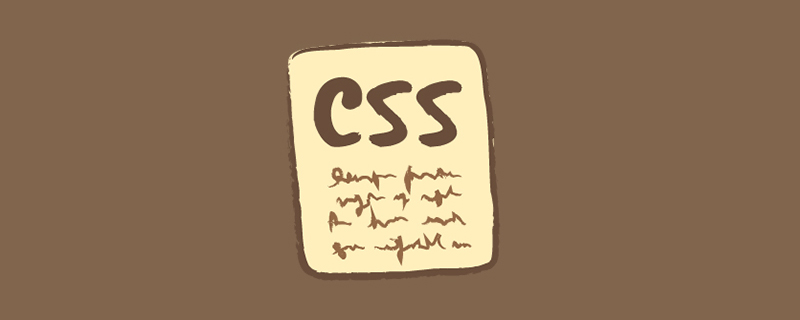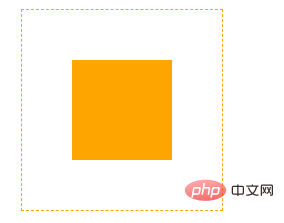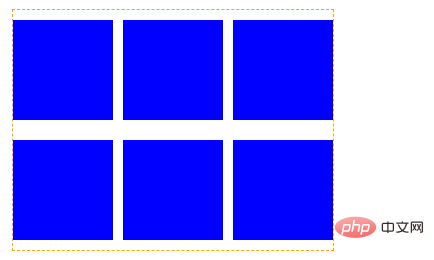Practical tips for CSS layout: negative margin values

Negative margins, that is, setting the value of the margin attribute to a negative value, is a very useful technique in CSS layout. Scenarios with positive values are very common, and everyone is familiar with its performance
When margin-top and margin-left are negative values, the element will be moved up and left, and at the same time The position in the document flow also changes accordingly, which is different from the position:relative element that still occupies its original position after setting top and left.
When margin-bottom and margin-right are set When it is a negative value, the element itself has no position change, and subsequent elements will move down and to the right
Look at a few application scenarios
Absolutely positioned elements
When an element is set to absolutely positioned, its top, right, bottom, and left values refer to the distance from the nearest non-static element. The classic vertical centering This method is achieved by using the negative margins of absolutely positioned elements.
<style>
.wrap4{
position:relative;
margin:10px;
width:200px;
height:200px;
border:dashed 1px orange;
}
.wrap4 .content{
position:absolute;
width:100px;
height:100px;
top:50%;
left:50%;
margin-top:-50px;
margin-left:-50px;
background:orange;
}
</style>
<div class="wrap4">
<div class="content"></div>
</div>Set the element to absolute positioning, and then set the top and left to 50%. At this time, the top and left sides of the element will reach the top and left of the parent element. At 50%, set negative margins to the element's own height and length, moving the center of the element to the center of the parent element to achieve center alignment

float element
The impact of negative margins on float elements is also as mentioned above, but it has its own particularities. Let’s look at an example to make it clear
Floating element negative margin
<style>
.float{
overflow:hidden;
width:280px;
border:dashed 1px orange;
}
.float .item{
width:100px;
height:100px;
float:left;
}
.float .item:nth-child(1){
background:red;
}
.float .item:nth-child(2){
background:grey;
}
.float .item:nth-child(3){
background:blue;
}
</style>
<div class="float">
<div class="item"></div>
<div class="item"></div>
<div class="item"></div>
</div>In a div with a width of 280px, there are three float:left sub-elements on the right, with a width of 100px. Since they cannot fit in one row, the last one has been moved to Next line

We slightly modify the code
<style>
.float{
overflow:hidden;
width:280px;
border:dashed 1px orange;
}
.float .item{
width:100px;
height:100px;
float:left;
}
.float .item:nth-child(1){
background:red;
}
.float .item:nth-child(2){
background:grey;
}
.float .item:nth-child(3){
background:blue;
margin-left:-20px;
}
</style>
<div class="float">
<div class="item"></div>
<div class="item"></div>
<div class="item"></div>
</div>Add a negative margin of -20px to the third element

At this time, I found that the third element moved up and covered the second element by 20px. The classic multi-column layout uses this principle
Multiple columns Layout
<style>
.body{
width:500px;
margin:10px;
border:dashed 1px orange;
overflow:hidden;
}
.wrap3{
float:left;
width:100%;
}
.wrap3 .content{
height:200px;
margin-right:100px;
background:rgba(255,0,0,0.5);
}
.body .right{
width:100px;
height:200px;
float:left;
margin-left:-100px;
background:rgba(0,255,0,0.5)
}
</style>
<div class="body">
<div class="wrap3">
<div class="content">
Content Content Content Content Content Content Content
Content Content Content Content Content Content Content Content
</div>
</div>
<div class="right">Right</div>
</div>The code is very simple
Add a parent element to the content element, set left floating, width 100%
The content element sets the right margin, the value is equal to the width of right
right floats left, and then sets the negative margin of its width
Originally, right should be displayed on the second line, but the left floating of its width brought it to the rightmost side of the first line, covering part of the wrap, but the content has a right margin of right width, and the covered area has no content, so Implemented two-column layout

Ordinary elements
Negative margins have a great impact on different block elements It’s interesting. Let’s take a look at a few examples.
Multi-column list
<style>
li{
line-height:2em;
}
.col2{
margin-left:150px;
}
.col3{
margin-left:300px;
}
li.top{
margin-top:-9em;
}
</style>
<ul>
<li class="col1">aaa</li>
<li class="col1">bbb</li>
<li class="col1">ccc</li>
<li class="col2 top">ddd</li>
<li class="col2">eee</li>
<li class="col2">fff</li>
<li class="col3 top">ggg</li>
<li class="col3">hhh</li>
<li class="col3">iii</li>
</ul>The common approach is definitely to implement it through floating. It shouldn’t be difficult with the knowledge just introduced. It’s okay to understand why this is the case. It seems that there is nothing unusual about ordinary elements
Amplified elements
What? Negative margins can also make elements larger! ! !
<style>
.wrap{
width:300px;
border:dashed 5px orange;
}
.wrap .inner{
height:50px;
margin:0 -50px;
background:blue;
opacity:0.5;
}
</style>
<div class="wrap0">
<div class="inner0">
inner inner inner inner inner inner inner inner inner inner inner inner
</div>
</div>This example looks ordinary, but the effect is amazing. The inner div becomes larger after setting horizontal negative margins

PS. The prerequisite for the effect to be achieved is that the width of the element cannot be set to a value other than auto
A list of floating child elements with right margin

What was your first thought when you saw this effect? Could it be that margin-right is set for the child elements, and nth-child(3n) is set to 0 during traversal? Let’s see how we can handle it using the above knowledge.
<style>
.wrap2{
width:320px;
border:dashed 1px orange;
}
.wrap2 .inner{
overflow:hidden;
margin-right:-10px;
}
.wrap2 .item{
float:left;
width:100px;
height:100px;
margin:10px 10px 10px 0;
background:blue;
}
</style>
<div class="wrap2">
<div class="inner">
<div class="item"></div>
<div class="item"></div>
<div class="item"></div>
<div class="item"></div>
<div class="item"></div>
<div class="item"></div>
</div>
</div>We did not set nth-child( 3n) has 0 margins, but uses negative margins to make the parent element "larger".
Isn’t negative margin very interesting? Teenagers who don’t know much about it should learn it!
For more programming-related knowledge, please visit: Programming Learning! !
The above is the detailed content of Practical tips for CSS layout: negative margin values. For more information, please follow other related articles on the PHP Chinese website!

Hot AI Tools

Undresser.AI Undress
AI-powered app for creating realistic nude photos

AI Clothes Remover
Online AI tool for removing clothes from photos.

Undress AI Tool
Undress images for free

Clothoff.io
AI clothes remover

Video Face Swap
Swap faces in any video effortlessly with our completely free AI face swap tool!

Hot Article

Hot Tools

Notepad++7.3.1
Easy-to-use and free code editor

SublimeText3 Chinese version
Chinese version, very easy to use

Zend Studio 13.0.1
Powerful PHP integrated development environment

Dreamweaver CS6
Visual web development tools

SublimeText3 Mac version
God-level code editing software (SublimeText3)

Hot Topics
 1670
1670
 14
14
 1428
1428
 52
52
 1329
1329
 25
25
 1274
1274
 29
29
 1256
1256
 24
24
 How to use bootstrap in vue
Apr 07, 2025 pm 11:33 PM
How to use bootstrap in vue
Apr 07, 2025 pm 11:33 PM
Using Bootstrap in Vue.js is divided into five steps: Install Bootstrap. Import Bootstrap in main.js. Use the Bootstrap component directly in the template. Optional: Custom style. Optional: Use plug-ins.
 Understanding HTML, CSS, and JavaScript: A Beginner's Guide
Apr 12, 2025 am 12:02 AM
Understanding HTML, CSS, and JavaScript: A Beginner's Guide
Apr 12, 2025 am 12:02 AM
WebdevelopmentreliesonHTML,CSS,andJavaScript:1)HTMLstructurescontent,2)CSSstylesit,and3)JavaScriptaddsinteractivity,formingthebasisofmodernwebexperiences.
 The Roles of HTML, CSS, and JavaScript: Core Responsibilities
Apr 08, 2025 pm 07:05 PM
The Roles of HTML, CSS, and JavaScript: Core Responsibilities
Apr 08, 2025 pm 07:05 PM
HTML defines the web structure, CSS is responsible for style and layout, and JavaScript gives dynamic interaction. The three perform their duties in web development and jointly build a colorful website.
 How to insert pictures on bootstrap
Apr 07, 2025 pm 03:30 PM
How to insert pictures on bootstrap
Apr 07, 2025 pm 03:30 PM
There are several ways to insert images in Bootstrap: insert images directly, using the HTML img tag. With the Bootstrap image component, you can provide responsive images and more styles. Set the image size, use the img-fluid class to make the image adaptable. Set the border, using the img-bordered class. Set the rounded corners and use the img-rounded class. Set the shadow, use the shadow class. Resize and position the image, using CSS style. Using the background image, use the background-image CSS property.
 How to write split lines on bootstrap
Apr 07, 2025 pm 03:12 PM
How to write split lines on bootstrap
Apr 07, 2025 pm 03:12 PM
There are two ways to create a Bootstrap split line: using the tag, which creates a horizontal split line. Use the CSS border property to create custom style split lines.
 How to set up the framework for bootstrap
Apr 07, 2025 pm 03:27 PM
How to set up the framework for bootstrap
Apr 07, 2025 pm 03:27 PM
To set up the Bootstrap framework, you need to follow these steps: 1. Reference the Bootstrap file via CDN; 2. Download and host the file on your own server; 3. Include the Bootstrap file in HTML; 4. Compile Sass/Less as needed; 5. Import a custom file (optional). Once setup is complete, you can use Bootstrap's grid systems, components, and styles to create responsive websites and applications.
 How to resize bootstrap
Apr 07, 2025 pm 03:18 PM
How to resize bootstrap
Apr 07, 2025 pm 03:18 PM
To adjust the size of elements in Bootstrap, you can use the dimension class, which includes: adjusting width: .col-, .w-, .mw-adjust height: .h-, .min-h-, .max-h-
 How to use bootstrap button
Apr 07, 2025 pm 03:09 PM
How to use bootstrap button
Apr 07, 2025 pm 03:09 PM
How to use the Bootstrap button? Introduce Bootstrap CSS to create button elements and add Bootstrap button class to add button text




